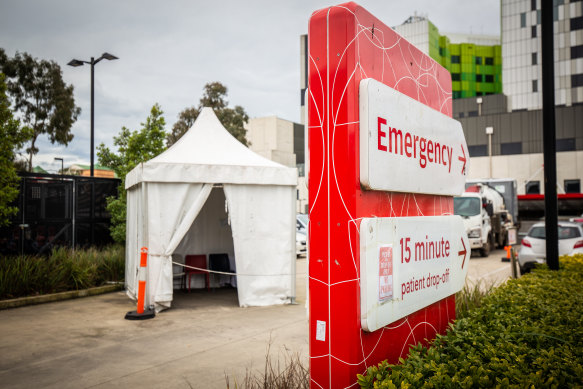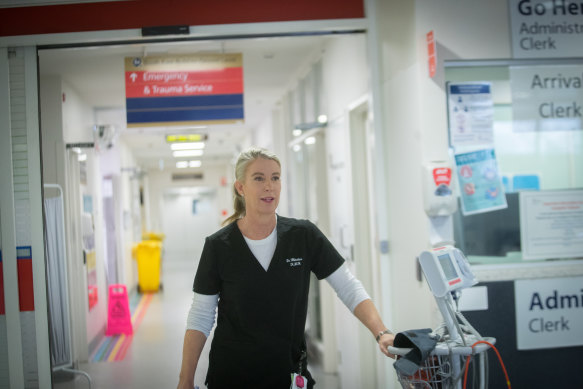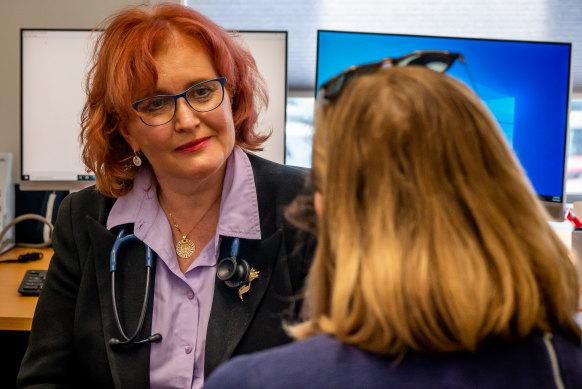By Aisha Dow
Out-of-hours medical care should be urgently examined and more patients assessed by general practitioners to help ease long waits at the state’s overloaded emergency departments.
Doctors pushing for the change argue that using GPs to make diagnoses and prescribe medication outside of usual practice hours would keep some patients out of Victoria’s emergency departments as they battle unprecedented levels of demand and chronic staff shortages.

Emergency departments are busier than ever in Victoria, with a tent being used by staff at Box Hill Hospital last year.Credit: Scott McNaughton
Emergency doctors say they often encounter patients who do not need to be at hospital, but have been referred by the 24-hour nurse-on-call hotline.
The Age spoke to several emergency doctors, general practitioners and paediatricians, who said the best solution lay in bolstering out-of-hours access to doctors at regular GP clinics, who know their patients best, by significantly increasing Medicare rebates.
Dr Sarah Whitelaw, an emergency medicine representative with the Australian Medical Association, said it was often difficult for patients and parents to know the best place to seek treatment and called for a system-wide review of out-of-hours medical care and advice.
She also warned against chastising patients as they tried to navigate a stressed health system.
“No one says ‘I want to hang out in the ED for the day’,” she said.

ED doctor Sarah Whitelaw.Credit: Simon Schluter
The comments came as Victorian and NSW premiers last week called on the federal government to overhaul Medicare, as Federal Health Minister Mark Butler declared “after nine years of cuts and neglect to Medicare, it has never been harder to see a doctor, and never more expensive.”
Melbourne GP Dr Karen Price believes the days of family GP surgeries being staffed around the clock were probably over but said proper funding would make it possible for medical centres to expand their opening hours.
“Most of the load of the non-acute stuff that doesn’t need to be in ED [likely happens] between that 6pm and 10pm slot anyway,” Price said, adding that if people woke up in the middle of the night in acute pain, they probably needed to be in an emergency.

Melbourne GP, Dr Karen Price.
It costs taxpayers about $500 to $600 for each emergency department presentation, but Dr Price estimated GPs could see patients after-hours for around a third, or less, of that figure.
The former president of the Royal Australian College of General Practitioners said families often needed reassurance or advice about how to manage sick children at home.
“People sometimes wait all day to see whether or not little Johnny or Ginny is going to get better, and then they don’t, so they’re worried. And they are quite sick, but they’re not sick [enough to need to go to a hospital].”
Doctors also said there was an element of people being more fearful, and less confident managing illnesses at home, after almost two years without many respiratory illnesses.
After hours options for Victorians include attending a pharmacist, calling a home-doctor service, visiting the Victorian Virtual Emergency Department (via video conference), or ringing nurse-on-call, which is a hotline that operates around the clock, giving advice to patients or carers about their health concerns.
In a bid to try to meet the gaps in out-of-hours care, the Victorian government has begun opening 25 new priority primary care centres staffed by GPs and nurses. Some of these are open in the evening.
And the Albanese government has similarly promised to open 50 urgent care clinics across the nation, including 10 in Victoria, open seven days a week, from 8am to 10pm.
However, doctors have criticised these initiatives as Band-aid fixes, instead a long-term solution: providing people with better access to their regular GP clinic and prompt access to other specialists.
“Solutions developed in isolation by individual branches of the health system can often be more expensive, confusing for patients who have to decide where to go, and we often don’t invest in the governance and data that allows us to see if they’re really working for patients,” Whitelaw said.
Whitelaw backed moves to support more GPs opening after-hours. Short of that, she said having GPs staffing medical advice hotline services like nurse-on-call was also valuable, as they could offer treatments and prescriptions and be less cautious in their advice about whether an ED visit was necessary.
A paediatrician working in an emergency department in Melbourne, who wasn’t authorised to speak publicly, said it was common for patients using nurse-on-call to be told to “see a doctor within six hours”, which can cause confusion after-hours.
“The advice is often very conservative and serves not to miss any patient with a serious condition given the limitations of a phone consultation,” they said,
“I think nurse on call is a really valuable service but also has limitations… there will be certain symptoms or findings that they pick up that they are taught to tell parents to seek more immediate attention for, however sometimes that advice needs to consider the availability of local resources ... and the time of the day.”
Healthdirect Australia, which operates nurse-on-call, said the majority of people were advised to see a general practitioner or “self-care”.
“This advice is reached through a combination of evidence-based clinical guidelines used by the nurses, application of the nurses’ clinical experience, and the individual situation of the caller which includes accessibility to the suggested healthcare provider,” a spokeswoman said.
Senior emergency department physician Dr Stephen Parnis said he was highly critical of the implementation of nurse-on-call more than a decade ago and had not seen any good data on the impact it has on presentations to emergency or general practice.
“They have algorithms. It’s done by nurses. It is on the phone, without any sort of visual aids and so it’s all very conservative.”
However, asked if he would prefer nurse-on-call to be replaced, he said there may be improved ways of offering the service involving senior nurses and GPs, now that many more people have access to video calls.
“When we are making an initial assessment of a patient, a picture is worth a thousand words,” he said.
A Victorian government spokeswoman said the primary care system was broken: “we’ll continue to advocate to the Commonwealth to prioritise primary care reform so Victorians don’t feel that emergency departments are their only choice for after-hours treatment.”
The president-elect of the Australasian College for Emergency Medicine, Dr Stephen Gourley, said the Commonwealth must immediately tackle and invest in the areas of federal responsibility that contributed to dangerous pressures in emergency departments, including Medicare, the NDIS and aged care.
“[Our] members report that, if these three areas of federal responsibility were properly resourced, the system would run more smoothly, patients needing beds would be significantly less likely to get stuck in EDs for days and more people would have access to the safe and timely care they need,” he said.
The Morning Edition newsletter is our guide to the day’s most important and interesting stories, analysis and insights. Sign up here.